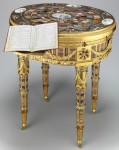 It’s a cultural institution throwing a bake sale to secure a national treasure again, this time the Louvre museum in Paris which needs the funding power of the crowd to purchase the Teschen Table, a masterpiece of 18th century goldsmithing, mineralogy and furniture-making that has an illustrious political history to boot. The table is priced at 12.5 million Euros, most of which the Louvre has already raised. The last remaining million ($1.67 million) they hope to raise in donations by January 31st, 2015.
It’s a cultural institution throwing a bake sale to secure a national treasure again, this time the Louvre museum in Paris which needs the funding power of the crowd to purchase the Teschen Table, a masterpiece of 18th century goldsmithing, mineralogy and furniture-making that has an illustrious political history to boot. The table is priced at 12.5 million Euros, most of which the Louvre has already raised. The last remaining million ($1.67 million) they hope to raise in donations by January 31st, 2015.
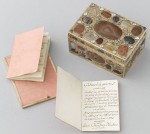 The table was made in 1779 by Johann-Christian Neuber, a goldsmith, jeweler and lapidary at the Dresden court of Frederick Augustus III, Elector of Saxony. Neuber became known for his gold snuff boxes inlaid with hardstones and gemstones. He called them Steinkabinettabatiere (stone cabinet snuffbox) because they were like miniature cabinets of curiosities. Neuber would number every stone and include a booklet with the numbered list identifying each mineral and where it was mined. His work combined the high craftsmanship of the goldsmith with the scientific approach of the geologist, and it was highly sought after by scholars and collectors alike. They weren’t easy to get as Neuber’s pieces weren’t for retail; they were usually given as gifts by the Elector of Saxony.
The table was made in 1779 by Johann-Christian Neuber, a goldsmith, jeweler and lapidary at the Dresden court of Frederick Augustus III, Elector of Saxony. Neuber became known for his gold snuff boxes inlaid with hardstones and gemstones. He called them Steinkabinettabatiere (stone cabinet snuffbox) because they were like miniature cabinets of curiosities. Neuber would number every stone and include a booklet with the numbered list identifying each mineral and where it was mined. His work combined the high craftsmanship of the goldsmith with the scientific approach of the geologist, and it was highly sought after by scholars and collectors alike. They weren’t easy to get as Neuber’s pieces weren’t for retail; they were usually given as gifts by the Elector of Saxony.
 In 1778, Frederick Augustus became embroiled in the War of the Bavarian Succession. Maximilian III Joseph, Prince-Elector of Bavaria, died childless of smallpox in 1777. A number of high-powered candidates vied to claim his title, among them Charles Theodore of Sulzbach, Prince-Elector and Count Palatine, who was the direct heir, Empress Maria Theresa of Austria, her son and co-ruler Holy Roman Emperor Joseph II, King Frederick II of Prussia and the Elector of Saxony. Negotiations between interested parties proposed various partitions, but nobody could agree on how to slice the Bavarian cake and in July of 1778, Austria and Prussia went to war.
In 1778, Frederick Augustus became embroiled in the War of the Bavarian Succession. Maximilian III Joseph, Prince-Elector of Bavaria, died childless of smallpox in 1777. A number of high-powered candidates vied to claim his title, among them Charles Theodore of Sulzbach, Prince-Elector and Count Palatine, who was the direct heir, Empress Maria Theresa of Austria, her son and co-ruler Holy Roman Emperor Joseph II, King Frederick II of Prussia and the Elector of Saxony. Negotiations between interested parties proposed various partitions, but nobody could agree on how to slice the Bavarian cake and in July of 1778, Austria and Prussia went to war.
![Top medallion detail, inscribed: To Breteuil, Ambassador and Peacemaker, Teschen May 13, 1779 (“Bretevillio legato pacificatori Teschen d[ie] XIII Maii MDCCLXXIX”). ©Philippe Fuzeau / Musée du Louvre](http://www.thehistoryblog.com/wp-content/uploads/2014/10/Top-medallion-To-Breteuil-Ambassador-and-Peacemaker-Teschen-May-13-1779-Bretevillio-legato-pacificatori-Teschen-die-XIII-Maii-MDCCLXXIX.-150x132.jpg) The conflict almost immediately settled into a stalemate. Maria Theresa, who was intimately familiar with how messy wars of succession could be, got Frederick of Prussia and her reluctant son to engage in peace talks brokered by Russia and France. France sent its Ambassador to Vienna, the Baron de Breteuil, to the Austrian Silesian town of Teschen, strategically located between Austria and Prussia, to negotiate a treaty in March of 1779. On May 13th, 1779, the belligerent parties signed the Treaty of Teschen. Charles Theodore would inherit Bavaria, but it and the Palatinate would combine to give him just the one vote in the election of the Holy Roman Emperor, and he would have to cede some territory to Austria. Austria had to recognize Prussia’s claim to the margraviates of Ansbach and Bayreuth. The Elector of Saxony got a sweet payoff of six million guilders.
The conflict almost immediately settled into a stalemate. Maria Theresa, who was intimately familiar with how messy wars of succession could be, got Frederick of Prussia and her reluctant son to engage in peace talks brokered by Russia and France. France sent its Ambassador to Vienna, the Baron de Breteuil, to the Austrian Silesian town of Teschen, strategically located between Austria and Prussia, to negotiate a treaty in March of 1779. On May 13th, 1779, the belligerent parties signed the Treaty of Teschen. Charles Theodore would inherit Bavaria, but it and the Palatinate would combine to give him just the one vote in the election of the Holy Roman Emperor, and he would have to cede some territory to Austria. Austria had to recognize Prussia’s claim to the margraviates of Ansbach and Bayreuth. The Elector of Saxony got a sweet payoff of six million guilders.
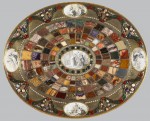 With six million extra guilders jingling in his pocket, Frederick Augustus was in a generous mood after Teschen. He gave the Russian representative, Prince Nikolai Wasilyevich Repnin, a Meissen porcelain service composed of hundreds of pieces and a large allegorical centerpiece (now lost) with bases made by Neuber. The Baron de Breteuil got Neuber’s masterpiece: a table made in the style of his snuffboxes only far grander, with miles of gilded bronze, stone insets 10 times larger than on the boxes and far more of them. On the tabletop there are 128 stones — including agate, amethyst, onyx, opal, topaz, sardonyx, jasper, petrified wood — all from Saxony. Five Meissen porcelain medallions bearing allegories of peace and art painted in grisaille by Johann Eleazar Zeissig (also known as Schenau), are placed in the center and cardinal points.
With six million extra guilders jingling in his pocket, Frederick Augustus was in a generous mood after Teschen. He gave the Russian representative, Prince Nikolai Wasilyevich Repnin, a Meissen porcelain service composed of hundreds of pieces and a large allegorical centerpiece (now lost) with bases made by Neuber. The Baron de Breteuil got Neuber’s masterpiece: a table made in the style of his snuffboxes only far grander, with miles of gilded bronze, stone insets 10 times larger than on the boxes and far more of them. On the tabletop there are 128 stones — including agate, amethyst, onyx, opal, topaz, sardonyx, jasper, petrified wood — all from Saxony. Five Meissen porcelain medallions bearing allegories of peace and art painted in grisaille by Johann Eleazar Zeissig (also known as Schenau), are placed in the center and cardinal points.
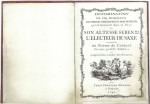 As he did with his snuffboxes, Neuber numbered each stone and created a booklet identifying the type and find site of every number. The numbering begins in the center of the table with the small round gemstones then continues clockwise in concentric circles. You can hover over the tabletop insets on this page to see what kind of stones they are and where they came from.
As he did with his snuffboxes, Neuber numbered each stone and created a booklet identifying the type and find site of every number. The numbering begins in the center of the table with the small round gemstones then continues clockwise in concentric circles. You can hover over the tabletop insets on this page to see what kind of stones they are and where they came from.
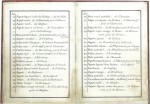 The hovertext can’t possibly do the booklet justice, however. For this very special assignment, Neuber commissioned Dresden artist and engraver Carl Gottfried Nestler to write every entry in the booklet in a hand so beautiful, so clean, so regular that if you didn’t know it was handwritten you wouldn’t believe it. Someone needs to make a Nestler font because that handwriting deserves to be immortalized.
The hovertext can’t possibly do the booklet justice, however. For this very special assignment, Neuber commissioned Dresden artist and engraver Carl Gottfried Nestler to write every entry in the booklet in a hand so beautiful, so clean, so regular that if you didn’t know it was handwritten you wouldn’t believe it. Someone needs to make a Nestler font because that handwriting deserves to be immortalized.
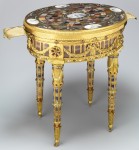 The table became famous in its own time. Historians wrote about it as early as 1782, and it even made a cameo in volume one of Marcel Proust’s Remembrance Of Things Past as a prized piece belonging to the Princesse d’Iéna. In the Swann In Love section, the terribly fashionable Princesse de Laumes laments that her husband wants her to visit the Princesse d’Iéna whom she does not know. She and General de Froberville have this exchange:
The table became famous in its own time. Historians wrote about it as early as 1782, and it even made a cameo in volume one of Marcel Proust’s Remembrance Of Things Past as a prized piece belonging to the Princesse d’Iéna. In the Swann In Love section, the terribly fashionable Princesse de Laumes laments that her husband wants her to visit the Princesse d’Iéna whom she does not know. She and General de Froberville have this exchange:
“But I must tell you what he’s told me about their house; it’s quite enough. Can you imagine it, all their furniture is ‘Empire’!”
“But, my dear Princess, that’s only natural; it belonged to their grandparents.”
“I don’t quite say it didn’t, but that doesn’t make it any less ugly. I quite understand that people can’t always have nice things, but at least they needn’t have things that are merely grotesque. What do you say? I can think of nothing more devastating, more utterly smug than that hideous style—cabinets covered all over with swans’ heads, like bath-taps!”
“But I believe, all the same, that they’ve got some lovely things; why, they must have that famous mosaic table on which the Treaty of…”
“Oh, I don’t deny, they may have things that are interesting enough from the historic point of view. But things like that can’t, ever, be beautiful … because they’re simply horrible! I’ve got things like that myself, that came to Basin from the Montesquious. Only, they’re up in the attics at Guermantes, where nobody ever sees them.
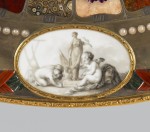 The Breteuil family did not hide it in the attic. It’s been at the Château de Breteuil about 25 miles southwest of Paris since 1821, leaving only on rare occasions on loan to museums for special exhibitions. In 2010, the family decided to sell the table to raise money to maintain the château and deal with some inheritance issues. They had a foreign buyer lined up and applied to the government for an export license. To block its export, the Teschen Table was declared National Treasure, but the block would expire in 30 months (March 31st, 2013) if the state did not acquire the piece.
The Breteuil family did not hide it in the attic. It’s been at the Château de Breteuil about 25 miles southwest of Paris since 1821, leaving only on rare occasions on loan to museums for special exhibitions. In 2010, the family decided to sell the table to raise money to maintain the château and deal with some inheritance issues. They had a foreign buyer lined up and applied to the government for an export license. To block its export, the Teschen Table was declared National Treasure, but the block would expire in 30 months (March 31st, 2013) if the state did not acquire the piece.
In July of last year, the Teschen Table was declared “a work of major patrimonial interest” which granted it another reprieve while funds were raised. The Louvre managed to scrape almost the entire value from its acquisition budget and corporate donors, but needs the aid of the public to reach the final goal. You can donate online here.